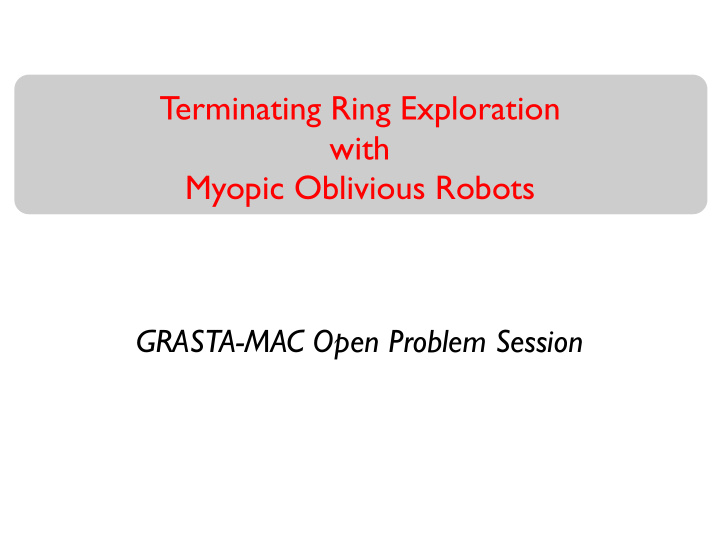



Terminating Ring Exploration with Myopic Oblivious Robots GRASTA-MAC Open Problem Session
Terminating Exploration Starting from an arbitrary configuration where no pair of robots are located on the same node ü Exploration Each node must be visited by at least one robot ü Termination Eventually, every robot stays idle
Challenges What are the minimal conditions to solve the exploration problem deterministically (probabilistically)? What is the minimal number of robots?
Related Work [ Flocchini et al. , OPODIS 2007] [ Devismes et al. , SIROCCO 2009] [ Lamani et al. , SIROCCO 2010][ Flocchini et al. , SIROCCO 2008] [ Flocchini et al. , IPL 2011][ Devismes et al. , SSS 2012] [ Devismes et al. , NETYS 2015] Unlimited visibility What is the solvability of terminating exploration assuming limited visibility?
Myopia Visibility limited to a certain fixed distance φ What is the solvability of terminating exploration assuming visibility limited to φ ?
Results & Open Problems φ = 1 [ Datta, Lamani, Larmore, and Petit, ICDCS 2013] ‣ Deterministic terminating exploration possible with synchronous robots only. φ = 2 ‣ Deterministic terminating exploration enabled with 7 asynchronous robots that start from a strongly connected configuration. [ Datta, Lamani, Larmore, and Petit, APDCM 2015] ‣ Does there exist another algorithm? ‣ Does there exist an algorithm that starts from a weak connected configuration? ‣ Optimality in terms of number of robots?
Results & Open Problems φ = 3 ‣ Deterministic terminating exploration enabled with an optimal number of asynchronous robots (5) that start from a strongly connected configuration. ‣ Deterministic terminating exploration 7 asynchronous robots that start from a weak connected configuration. [ Datta, Lamani, Larmore, and Petit, APDCM 2015] ‣ Does there exist a deterministic algorithm that start from a weak connected configuration with less robots? ‣ Is φ = 3 as powerful as φ = ∞ (with the extra requirement of initial weak connection)? ‣ Does there exist a generic algorithm with 5 ≤ k ≤ n-1 ?
Results & Open Problems 3 < φ ≤ n/2 (equiv. ∞ ) ‣ Generic algorithm from some φ≥ 3? ‣ Relationship between φ different knowledges, namely n and k? ‣ Relationship between φ different knowledges, namely n, k and multiplicity? ‣ Extension to other topologies?
More recommend